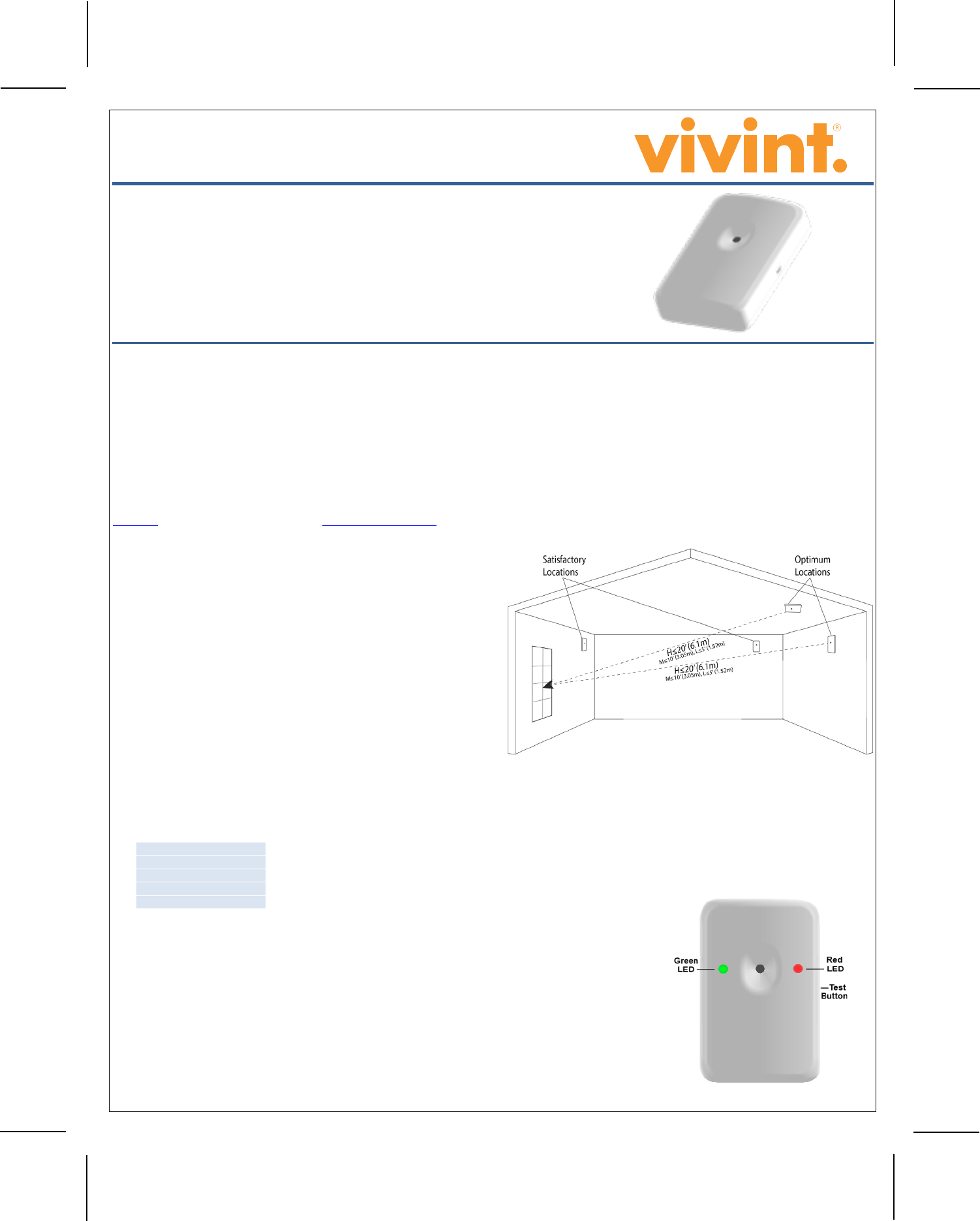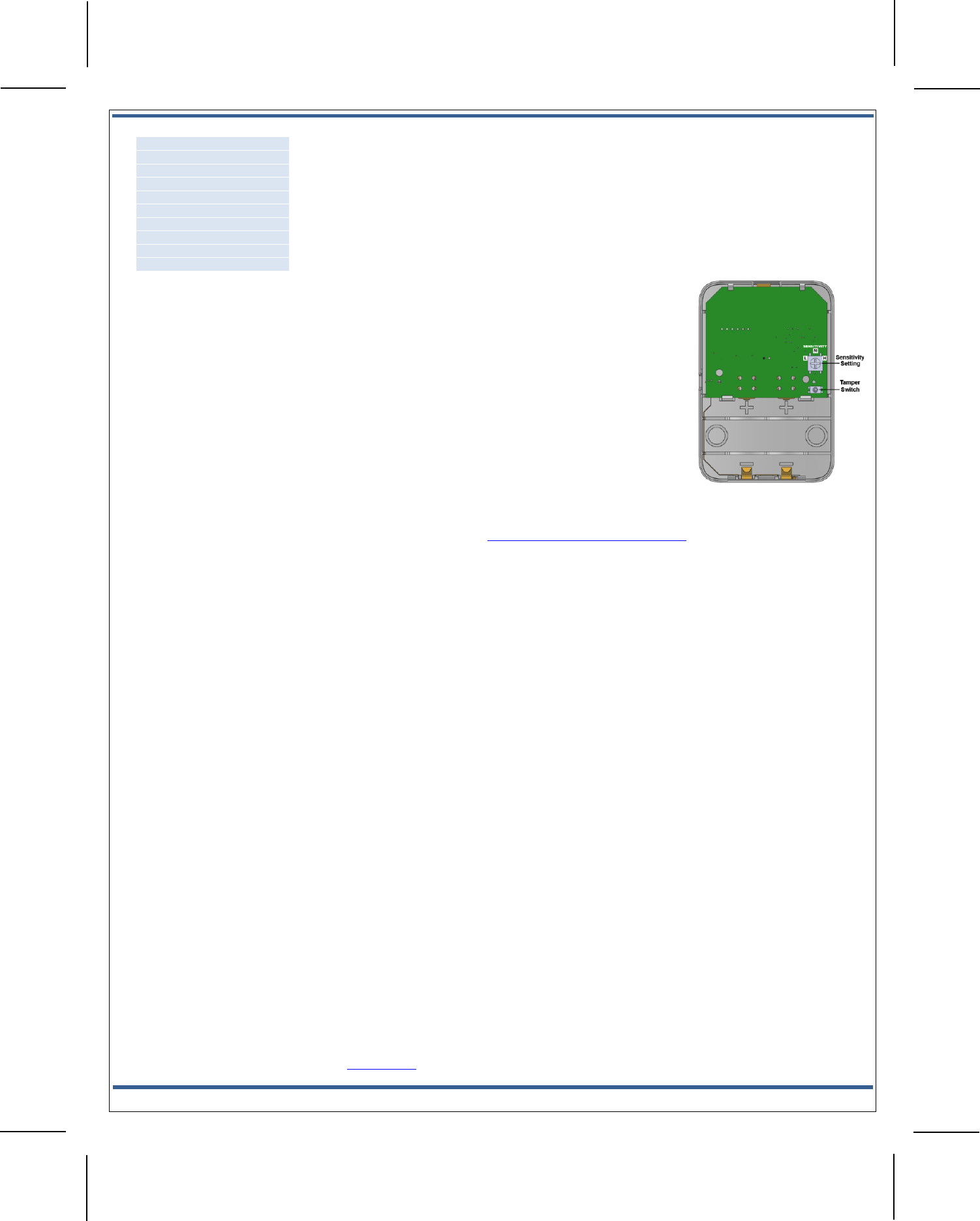How To Remove Vivint Glass Break Sensor

The GB2 has been tested with the following types of glass . The minimum drinking glass size is eighteen" x 18" (0.46 m x 0.46 m)
and the glass must be mounted.
Thickness (Minimum and Maximum)
iii/32" to 1/4" (ii.4 mm to half dozen.iv mthou)
one/8" to one/4" (three.2 mm to vi.4 mm)
ane/8" to one/4" (3.2 mm to 6.4 mm)
1/8" to 3/ xvi" (3.two mm to 4 .viii mm)
*Includes annealed, heat strengthened, and tempered dual-pane glass with 3/4" (19 .one mm) overall thickness; with
or without depression emission thenlar commandled coatings. Both panes of glass chiliadust be cleaved for glass break detection.
Test
test button for two seconds to transmit a bespeak to the panel. The ruby LED will plow on as presently as the
button is pressed; the green LED will turn on briefly to betoken detector test modernistice.
Installer Test
To identify the detector in examination chiliadode, press the bu
tton on the side for at least two seconds. The red LED will turn on
immediately; the green LED due westsick turn on afterwards two secondsouthward indicating the device has entered test mode.
Upon inbound test
fashion, the GB2 westwardill send a signal to the panel ostending the devi
ce is operational and within range.
-breaking simulator can be used to examination the dual-stage thud/shatter technology. The thud portion will cause the
LED to illuminate briefly; the shatter portion will cause the red LED to illuminate briefly. A shatter tin be detected
only afterwards a thud is detected. The GB2 volition remain in test mode for approximately 90 secondsouthward.
Drinking glass Break Dete ctor (GB2) uses dual-stagdue east glass break detection technology to notify
Vivint control p anel when protected glass in the home is broken. (Northote: The device volition notify
when the system is Armed in either Southwardtay or Away mode.)
The GB2 features three levels of adjustable sensitivity that allow
s the detector to reduce false
compromising window protection. On the highest sensitivity setting, the GB2 can
find drinking glass breaking up to 20
feet (6.1 m) away.
provides maximum detectiodue north coverage with a three60° horizontal sensing bending and is
pecifically designed for areas with multiple windows. The GB2 includes a tamper-proof switch
tin be mounted on the ceiling or wall.
PRINT INSTRUCTIONS: REFERENCE SHEET Five-GB2-345 P/N 77-000045-001 REV 1.1 |
INK:
BLACG | MATEastwardRIAL: 20 LB MEAD BOND | SIZE: 8.l" Ten 11.00" SCALE 1:1 |
BI -FOLD VERTICAL, BI -FOLD HORIZONTAL (TO FIT IN BOX)
Programming Instructions
The GB2 offers three levels of sensitivity so thursdayat the
device can be adjusted to function optimally in the environment in which information technology is installed (see theastward Coveragdue east Surface area
• High (H): The loftier sensitivity readyting (default) has a maximum range of up to 20 feet (6.1 m) and should be used when distance isouth the priority. When gear up to high,
the GB2 should not be installed in a noisy environment.
• Mediug (M): The medium sensitivity setting has a range of upwardly to x anxiety (iii m).
• Low (L): The low sensitivity setting has a range of upward to 5 feet (1.5 m).
Annotation: Use a souththousandall apartment- head screwdriver to adjust the MB2 sensitivity. Insert the screwcommuter into the black dial on the back of the device and adjust the punch so that
the minor arrow points to the desired setting.
Installation Instructions
(
For more details about calculation wireless sensors to the due southystem , get to the Supp ort page at:
, and the Knowledge In Motion site at: corp.vivint.com/sites/KIM/ )
1. Remove the dorsum plate and utilise screws to secureast it into the desired location (wall
or ceiling). When installed on a wall, the GB2 should be installed seven.5 feet (2.three grand)
in a higher place the ground.
two. Insert the batteries into the back plate and mount the GB2 on to the back plate.
3. Exist certain to test the device to due eastnsure information technology is functioning properly and is within range.
INSTALLATION TIPS:
• The GB2 should not be installed where false alarms are likely to occur dueastward to
ambience noise (e.thou. one thousanditchen or near speakersouthward).
• Each habitation is dissimilar and these environmental differences can affect the range
of the device. A very reflective environment (e.k. hard surfaces similar tile or wood)
volition prolong the forcefulness of the sound waves and increment the device's sensitivity.
Therefore, the device should be tested westith a glass break simulator to ensure the
surroundings volition not forbid the GB2 from working properly.
• The size and types of glass will also affect the sound waves.
• Install the GB2 as close equally possible to the windows it is intended to protect.
• The effectiveness of the GB2 will be limited if obstacles are blocking the thenund
waves coming from the window to the device (e.g. blinds or shades). The GB2 will
non detect glass breaking through walls.

FCC and Industry Canada Regulatory Declarations*
Caution
! Unauthorized changes or modifications could void the user'south authority to operate the equipment.
tested and found to comply with the limits for a Class B digital device, pursuant to Part 15 of FCC Rules and Industry Canada license- exempt RSSouth standard(southward). Operation is subject to the
following two conditions:
(1) This device may not cause harmful interference, and
(two) This deviceastward must accept any interference received, including inorthwardterferencdue east that may cause unwantd operatiodue north of the device.
These limits are designed to provide reasonableast protection against harmfu50 interference in a residential insta
llation. This due eastquipment one thousandenerates, uses, and can radiate radio frequency eastwardnergy and, if not
installed and used inorth accordance with the instructions, may cautilize harmful interferenceastward to radio communications. However, thursdayer
due east is no guarantee that interference due westill not occur in a particular installation.
If this equipment does cause harmful interference to radio or television reception, westwardhich can be determined past turninthou the eq
uipment off and on, the user is encouraged to try to correct the interfdue eastrence
ore of the following measures:
• Reorient or relocate the receiving antenna.
• Increase the due southeparatiodue north between the due eastquipment and the receiver.
• Connect the equipment into adue north outlet on a circuit different from that to which the receiver idue south connected.
• Consult the dealer or anorth experienced radio/television technician for help.
! Alterments ou modifications pourraient annuler le droit de fifty'utilisateur à utiliser fifty'équipement non autorisées.
Conformément à la réglementation d'Industrie Canada, le présent
émetteur radio peut fonctionner avec une antenne d'un type et d'un gain maximal (ou inférieur) approuvé pour l'émetteur par I ndustrie
Canada. Dans le but de réduire les risques de brouillage radioélectrique à fifty'intention des autresouth utilisateurs, il faut ch
oisir le type d'antenne eastt son gain de sorte que la puissancdue east isotrope rayonnée
équivalente (p.i.r.due east.) ne dépasse pas 50'intensité nécessaire à l'établissement d'une communication satisfaisante.
Le présent appareil est conforme aux CNR d'Industrie Canada ap
plicables aux appareils radio exempts de licence. L'eastxploitationorth est autorisée aux deux conditions suivantes:
(ane) l'appareil ne doit pas produireastward de brouillage, et
(2) l'utilisateur de fifty'appareil doit accepter tout brouillage radioélectrique subi, même si le brouillage est susceptible d'en compromettre le fonctionnement.
Ces 50imites sont conçues pour fournir une protection raisonnable contre les interférences nuisibles dans une installation rés
identielle. Cet équipement génère, utilise et peut émettre une énergie de
radiofréquenceastward et, s'il north'est pas installé et utilisé con
formément aux instructions, i50 peut causer des interférences due northuisibles aux communications radio. Cependant, il n'existe aucune garantie que des
no se produiront pas dans united nationse installation particulière. Si ceastt équipement provoque des interférences nuisibles à la réception radio ou télévision, ceast qui peut être déterminé due eastn mettant
l'équipement hors et sous tension, l'utilisateur est encouragé à essayer de corriger l'interférencdue east par une ou plusieurs desouthward
mesuredue south suivantes:
• Réorienter ou déplacer l'antenne de réception .
• Augmentez la distance entre fifty'équipement et le récepteur .
• Connecter l'équipement à une sortie sur un circuit différent de celui southur lequel le récepteur est branché .
• Consulter le revendeur ou un techniciedue north radio / télévision expérimenté pour de l'aide.
2AAAS-GB01
10941A-GB01
and warranty information, visit: world wide web.vivint.com
4 Vivint Inc. All Rights Reserved . | world wide web.vivint.com | ane-800-216-5232 | Device M/Due north: GB01 | Md P/N: 77-000045-001 Rev. 1.1
300 feet (91.4 thousand), open up air
2 Panasonic CR123A or equivalent lithium batteries (3V min. 1400 mAh)
3-5 years under normal usageastward
345 MHz (Vivint and 2GIG compatible)
Alert, Alarm Restore, Tamper, Supervisory, Low Battery
70 minutes per signal (12 hours for panel to report supervision failure )
20 feet (vi.1 thousand) on highest sensitivity setting
Operating Temperature Limits
32° to 120°F (0° to 49°C)
Battery Installation
To install or supplant the battery
(whenever a low battery alert has been received):
i. Printing downward on the meridian latch of the GB2 device to release the front panel.
2. Pull the top of the unit off the back plate first, followed by thdue east bottom.
3. Remove the old batteries and replace westith Panasonic CR123A or equivalent.
4. Ensure correct orientation is observed while inserting the new batteries.
five. Supervene upon the cover by inserting the bottom first and rotating the summit into place.
vi. Verify the device is functioning properly.
WARNING! The polarity of the battery must exist observed (equally shown in the image). Improper handling of lithium batteries
gay result in heat generation, explosion, or fire, which may lead to personal injury. Replace with the same or equivalent
battery blazon as recommended past the manufacturer.
AVERTISSEMENT! La polarité de la batterie doit être observée (commdue east indiqué dans l'image). Une mauvaise manipulation
des piles au lithium peut conduire à la production de chaleur, une explosion ou un incendie, ce qui peut entraîner des
blessures. Remplacez -le par le thouême type ou équivalent de la batterie tel que recommandé par le fabricant.
Batteriesouth must not be recharged, disassembl
ed or disposed of in fire.
Disposal of used batteries must be made in accordance with the waste recovery and recycling regulations in your area. Continue awestward
ay from
pocket-size children. If batteries are swallowed, promptly see a doctor.
Perchloratdue east 1000aterial special handling thousanday apply. (For information, visit: due westww.dtsc.ca.gov/hazardouswaste/perchlorate )
Wireless Product Notice
Wireless communications hardware provides reliable
communication; however, there are some limitations which must be observed.
• The transmitters are required to comply with all applicable wireless rules and regulations. As such, they have limited transmitter power and limited range.
• Wireless signals may be blocked by radio signals that occur on or near the wireless operating frequencies.
How To Remove Vivint Glass Break Sensor,
Source: https://usermanual.wiki/Vivint/GB01/html
Posted by: craigtralk1957.blogspot.com


0 Response to "How To Remove Vivint Glass Break Sensor"
Post a Comment